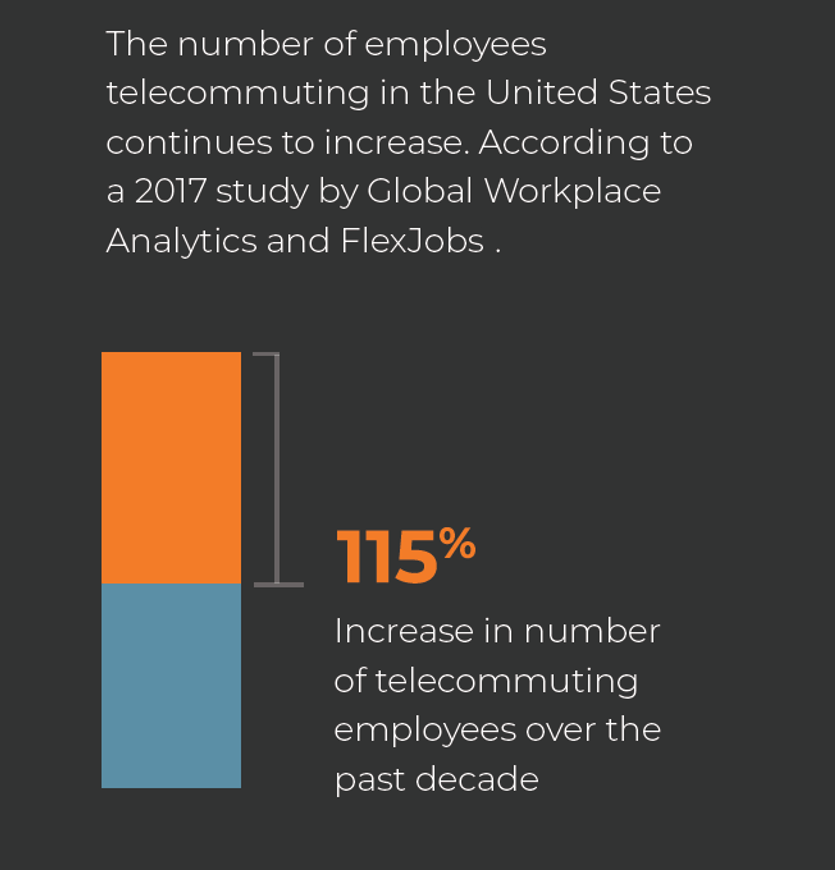
As opposed to centralized cloud storage that requires transferring and storing duplicated files over the internet to a central data center located miles away, the decentralized hybrid-IT zero-trust architecture of FileFlex Enterprise addresses the inefficiency issues of uploading, downloading and syncing subsets of data to the limited storage capacity of cloud servers.
The Movement to a Distributed Workforce
How employees accomplish their work, and where they accomplish it from, is changing. Not that  long-ago, employees clocked in and resigned themselves to their desks for long stretches of time to accomplish their work. Although laptops, tablets, and smartphones have enabled them mobility, most employees had to physically go to the office in order to access files stored on corporate network servers. But that's changing. Today, a vast majority of companies allow employees to work outside the office and may even contract with a remote, virtualized workforce to handle a variety of tasks from customer service to software development. The result? The number of telecomputing people signing into corporate network resources from home offices, co-working spaces, and even other countries has increased 115% over the past decade [1].
long-ago, employees clocked in and resigned themselves to their desks for long stretches of time to accomplish their work. Although laptops, tablets, and smartphones have enabled them mobility, most employees had to physically go to the office in order to access files stored on corporate network servers. But that's changing. Today, a vast majority of companies allow employees to work outside the office and may even contract with a remote, virtualized workforce to handle a variety of tasks from customer service to software development. The result? The number of telecomputing people signing into corporate network resources from home offices, co-working spaces, and even other countries has increased 115% over the past decade [1].
This new trend of telecommuting or teleworking has, in fact, become the norm. It's an employment perk in today's business world and companies need to offer it to attract and keep the best talent—flexible work schedules that include some time at home and some time in the office. But having a distributed workforce introduces an interesting problem— how does a business make it cost-efficient and secure for those workers, both on the corporate network and outside of the corporate campus, to collaborate on documents?
Centralized Cloud Storage Enables the Remote Workforce
Today's traditional centralized cloud storage is a key enabler of the remote distributed workforce. It is a tool used to enable collaboration and joint authorship between team members on projects, as well as a tool that enables remote access to key files and for sharing files that are too big to email. Because it is a critical component that enables employees to work from home, according to RightScale 95% of all companies now use the cloud is some fashion. [2]
But cloud storage comes with a productivity price
Because of the tremendous benefits we tend to think of cloud storage as all goodness. Did you realize however, that despite these revolutionary benefits, cloud storage comes with a productivity price to pay? The price comes from time spent by users uploading, downloading, creating links and administering their cloud storage. If they were all in the office and on the same local area network, they would simply use shared network storage. They would not need to upload, download or create links. But when using cloud storage instead of network storage, every change and edit must be uploaded and downloaded by everyone on the team – even if they are sitting in side-by-side cubicles – for the benefit of workers who are remote. If the files are big and the wait times are longer, then expect employees to go get a coffee and have a chat with someone while they are waiting. A recent Harris Interactive poll reports that 83% of employees waste time due to document collaboration issues.[3]
How cloud storage negatively impacts worker productivity
For many organizations, the impact of lost productivity resulting from the use of cloud storage is growing. Employees can spend countless hours over the course of a month, uploading and downloading large files to cloud storage tools in order to collaborate. And what happens when a file isn't synchronized to that cloud storage? Remote employees, whether at their home office or in the field, must wait until they connect to the corporate network to retrieve the file they need. Of course, there's always email, but it's not really a viable solution for very large files. And if using a public or EFSS cloud it might seem like the perfect solution until the security realization settles in—using the public and EFSS cloud introduces a significant risk to the privacy of confidential information and data exfiltration. Yes, there are other methods to remotely share documents, such as costly and cumbersome VPNs and private cloud software, but they all fall short in some critical ways. And, remote employees feel the pinch too. They become far less productive when they can't access the files they need to behind the company firewall.
We need a new model
Let's face it, telecommuting is a way of doing business today. More employees are enjoying a flexible work environment and companies are benefiting, but only when productivity between in-office and remote employees can be assured. Maintaining that productivity requires employees to have access to the files they need, securely, from the devices they use without having to waste valuable time uploading and downloading from the cloud or emailing new versions. A decentralized hybrid-IT platform is the solution.
The Decentralized Hybrid-IT Architecture of FileFlex Enterprise is the Answer
As opposed to centralized cloud storage that requires transferring and storing duplicated files over the internet to a central data center located miles away, the decentralized hybrid-IT architecture of FileFlex addresses the inefficiency issues of uploading, downloading and syncing subsets of data to the limited storage capacity of cloud servers. With FileFlex the central server acts like a switchboard to facilitate a hybrid point-to-point connection and as a policeman to enforce policies. It does not storage any data. Instead, data stays in source locations which all now have cloud functionality of remote access, sharing, streaming, remote editing and file management. Privacy and confidentiality can be protected by keeping data in source locations, on-premises, behind the corporate firewall, on corporate storage assets, in specific geographic regions and access controlled. Also, with this technology users can access all storage not just a subset that is duplicated to a central server. And because it leverages the existing storage and servers the organization already owns, organizations do not have to build a private cloud or subscribe to an expensive EFSS service making it is the lowest cost model.
How much lost productivity is regained? The answer will shock you.
Consider the use case of an architecture firm with 100 architects working with very large files. They have decided to team file editing on projects using the cloud. So, to work on a file, each architect must download it first, make changes, and re-upload it. If each one of them spends one hour per week uploading AutoCAD files to the cloud so that 10 remote workers can be more productive, then they are wasting 100 hours uploading and downloading that could be better spent. If the average compensation of those employees worked out to $100 per hour, the cost to the company would be $10,000 per week or $520,000 per year… just so 10 remote workers can remotely edit and contribute.
Shocking productivity gains even for common office work
But wait. Most companies don't have large teams of highly paid architects working on huge AutoCAD files. Most work on Office files such as Word, Excel or PowerPoint. Well, even if they are spending only 0.1 of an hour (or 6 minutes) each week managing uploading, downloading and creating links. The company still loses $1100 per employee per year in lost productivity that can be recovered if they spent $120 per employee per year on FileFlex and accessed source locations instead.
Not convinced? Go ahead and calculate your own cost of productivity lost due to using cloud storage with our online calculator. Set your own assumptions of what you think is realistic for you and check out the results for yourself. It will be an eye-opener.
Open the Productivity Calculator
Conclusion
FileFlex Enterprise is the perfect solution to enable a distributed workforce, checking all the boxes for both IT and executives who are looking to streamline productivity and cut wasted time out of their employee's days while out-performing existing remote file sharing platforms like the public cloud and complicated EFSS software. FileFlex is the perfect tool to help mitigate the impact of using traditional centralized cloud storage while enabling better, more effective collaboration between in-local-network and out-of-local-network personnel.
Get the full whitepaper.
How the Decentralized Hybrid-IT Archtecture of FileFlex Improves Productivity
[1] https://www.flexjobs.com/2017-State-of-Telecommuting-US/
[2] http://assets.rightscale.com/uploads/pdfs/RightScale-2017-State-of-the-Cloud-Report.pdf/
[3] http://info.perforce.com/rs/perforce/images/versioning-report.pdf
